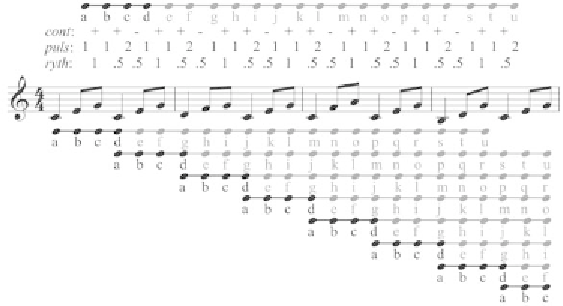Information Technology Reference
In-Depth Information
Figure 12. Multiple successive repetitions of pattern abcd logically lead to extensions into patterns e,
f, etc. which form a complex intertwining of structures
represented. But the less specific pattern
afghi
will be represented once the last occurrence is
discovered, as it is not an occurrence of the more
specific pattern
abcde
.
last state (
d
) to the first state (
a
) (Figure 13). The
initial acyclic pattern
d
leads, therefore, to a cyclic
pattern that oscillates between three
phases
b'
,
c'
and
d'
. Indeed, when listening to the remainder
of the musical sequence, we actually perceive
this progressive cycling. Hence this cycle-based
modeling seems to explain a common listening
strategy, and resolves the problem of combinato-
rial redundancy.
This cyclic pattern (with three phases
b'
,
c'
and
d'
at the top of Figure 13) is considered as a
continuation of the original acyclic pattern
abcd
.
Indeed, the first repetition of the rhythmic period
is not perceived as a period as such but rather as
a simple pattern: its successive notes are simply
linked to the progressive states
a
,
b
,
c
and
d
of
the acyclic pattern. On the contrary, the follow-
ing notes extend the occurrence, which cannot
be associated with the acyclic pattern anymore,
and are therefore linked to the successive states
of the cyclic pattern (
b', c'
and
d'
). The whole
periodic sequence is therefore represented as a
single chain of states representing the traversal of
the acyclic pattern followed by multiple rotations
in the cyclic pattern.
This additional concept immediately solves
the redundancy problem. Indeed, each type of
redundant structure considered previously is
cyclic patterns
Combinatory explosions can be caused by another
common phenomenon provoked by successive
repetitions of a same pattern (for instance, in
Figure 12, the simple pattern
abcd
, a succession of
one fourth note and two eighth notes forming two
ascending and one descending contours). As each
occurrence is followed by the beginning of a new
occurrence, each pattern can be extended (leading
to pattern
e
) by a new interval whose description
(an ascending crochet interval) is identical to the
description of the first interval of the same pattern
(i.e., between states
a
and
b
). This extension can be
prolonged recursively (into
f
,
g
,
h
,
i
, etc.), leading
to a combinatorial explosion of patterns that are
not perceived due to their complex intertwining
(Cambouropoulos, 1998).
The graph-based representation (Figure 12)
shows that the last state of each occurrence of
pattern
d
is synchronised with the first state of
the following occurrence. Listeners tend to fuse
these two states, and to perceive a loop from the

Search WWH ::

Custom Search